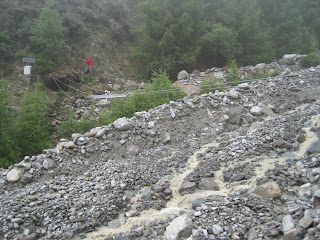Mountainous terrains are susceptible to gravitational hazards processes such as shallow landslides. In the majority of cases the main trigger is heavy or prolonged rainfall on steep slopes. Shallow landslides are mixtures of water, soil and debris at high speed, which have long been a significant cause of damage and destruction to property, infrastructure and claiming people's lives.
The interaction between shallow landslides and flexible barriers, as a hazard mitigation systems, are investigated in Veltheim (Argovia), Switzerland . Full-scale experiments were conducted by WSL and SLF in collaboration with Geobrugg AG company.
The shallow landslide simulation is accomplished in a chute test with 40 m long and 30° slope. The top part of the chute has a release mechanism which contains a mixture of soil and gravel saturated with water with a total about 60 m3. The flow travels down the test slope with a speed of 35 km into a flexible barrier at the bottom of the slope.
 | |
 |
| Lock-gate open |
 |
| Lock-gate holding the mixture before release |
The flexible barrier is made from high-tensile steel wire. Brake rings are integrated in the support and border ropes as energy dissipating elements avoiding damaging the ropes.
The break rings are pipes bent into loops, which act as brake rings. To evaluate the absorbed energy by the brake rings, these are marked with red paint as it is shown in the picture. After each landslide simulation, the brake rings are contracted absorbing the residual energy without damaging the ropes. The red marks are more separated after each event.
Along the test track and at the anchorages of the flexible barrier measurements devices were installed: (1) laser devices to measure flow heights and front speed, (2) force plate to provide normal and shear basal forces, (3) load cells for impact pressures and (4) load cells at the anchorages to record load distribution during impact.
The measurement date are used to full understand the shallow landslide flow mechanisms and to evaluate the performance of the flexible barriers. Additional small scale laboratory experiments are used to develop new models for such debris flows. These enable the industrial partner Geobrugg AG to develop optimum protective barriers. Ultimate goal is to dimension the flexible barriers both cost-effectively and reliably as a portection system agianst shallow landslide flows.
 |
| Albrecht Von Boetticher from WSL (above) and Paloma Paleo (below) measuring the marked knot positon after each event by using Leica System device. |

 |
| Participants (guests of Geobrugg company) to the test site visit of flexible shallow landslide barrier subjected to multiple impact, Veltheim 30.03.2011. |












































